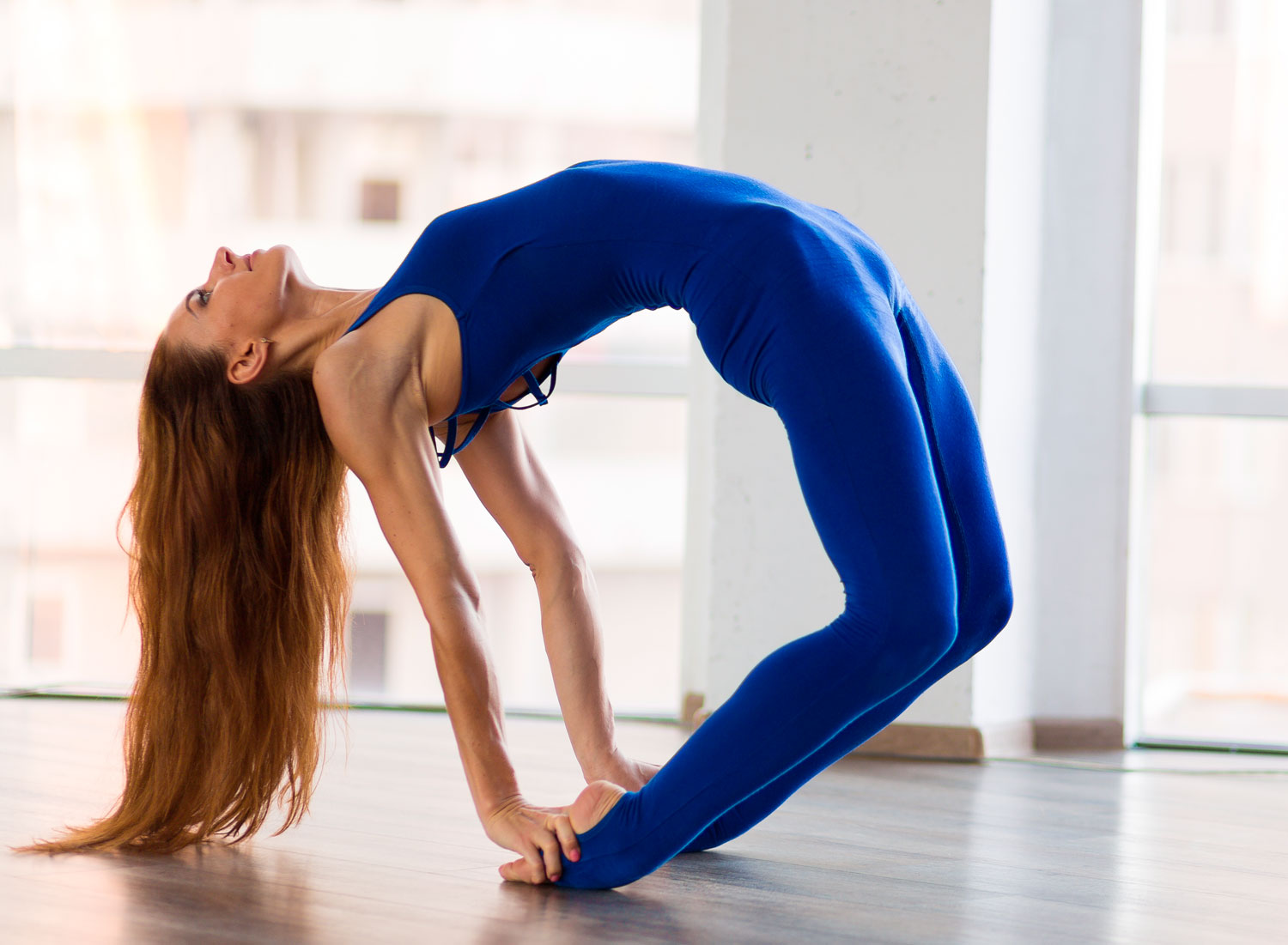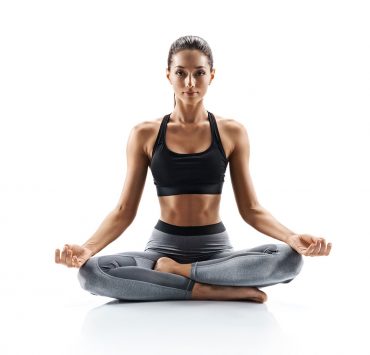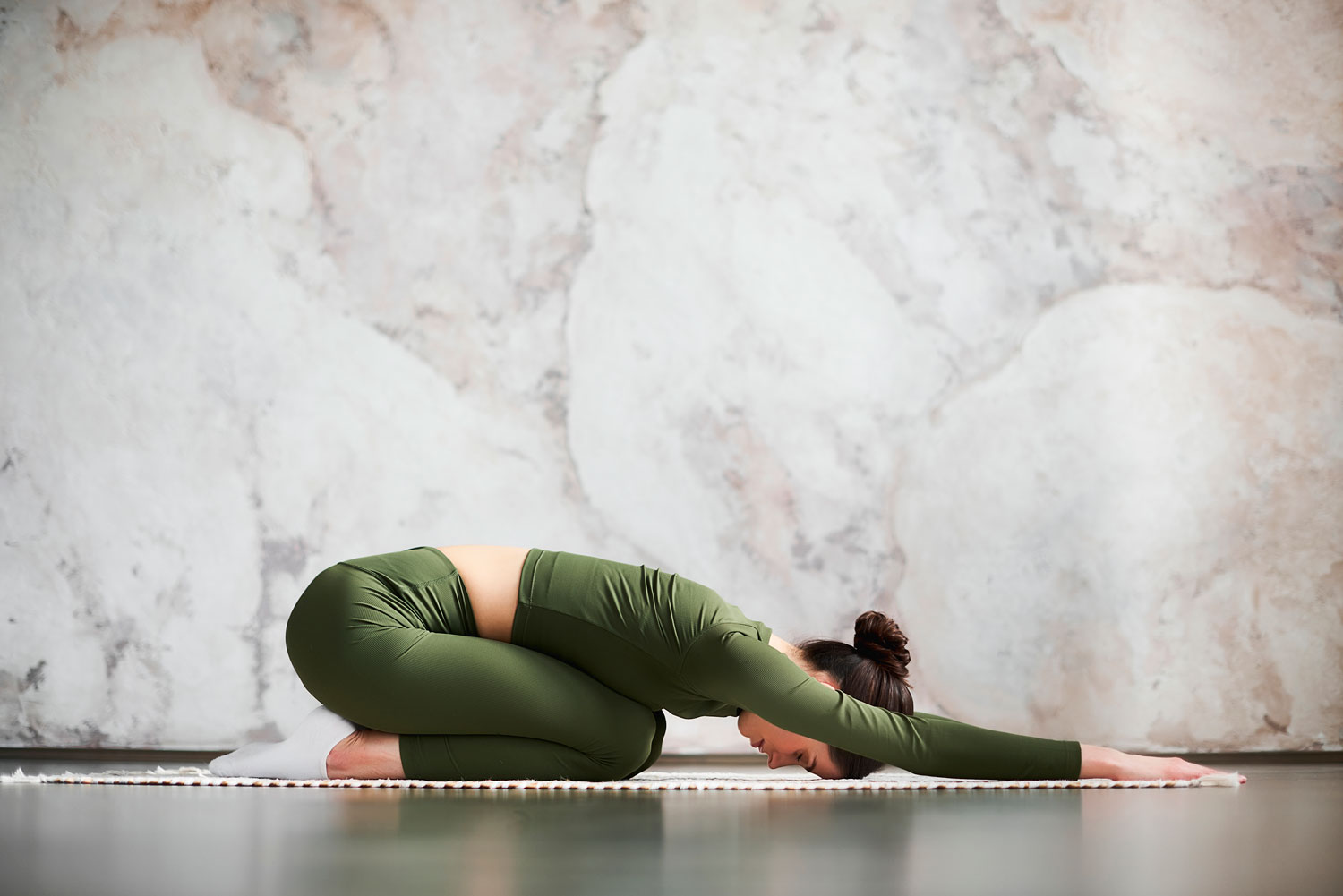
A graduate of Arizona State University, Nicole Baker is a…
As people age, balance improves overall health. Not only does balance help from tumbles that can cause broken bones and possible head injuries but a lack of balance tends to cause a lack of activity. Inactivity can create a downward spiral of not only injuries but health-related conditions. Additionally, working on balance can help athletes perform better and help with regular to day to day activities such as lifting packages and walking on uneven surfaces. Practicing yoga asana can help improve flexibility and strength but can greatly improve physical balance. Incorporating a standing sequence of yoga postures can greatly improve balance.
Mountain Pose — Tadasana Pose

Mountain (Tadasana) is the absolute foundation of all standing yoga postures. When done correctly benefits of the posture include improved balance, better posture, strengthening of the legs, toning of the upper body, and reduction in flat feet. It can create a sense of grounding in the body and courage.
Principles of this simple but effective pose apply to all subsequent postures. While practicing,, concentrate on how the body is being held, the distribution of weight in the feet, what muscles are being activated, and the sense of energy in the body. Moving through other standing postures should have those same crucial elements sensed in the body.
There are several variations of the posture depending on lineage and individual ability. The feet can be together where the big toes touch or with the feet hip-distance apart. In both variations, the inside edges of the feet are parallel. Stand tall and notice the feet on the earth and try to equally distribute weight between the balls and heels of the feet while pressing down evenly to the sides. Engage the thighs by lifting them up slightly toward the hip flexors. Point the tailbone to the heels to engage the mula bandha. Strengthen the upper body while widening the collarbones. Breathe deeply to feel the expansion of the heart area while relaxing the shoulders. Allow the jaw and the space between the eyebrows to soften. Lift the crown of the head toward the sky upward with the torso as the legs ground you down to the earth.
Hold steady in the posture breathing deeply practicing balance in this simple yet foundational posture.
Upward Salute — Urdhva Hastasana Pose

Upward Salute (Urdhva Hastasana) builds upon mountain pose. Additional benefits include: stretching the belly, improving digestion, and possibly reducing stress and anxiety.
When practicing upward salute, the same foundations of mountain pose apply. Start in mountain pose and rotate the palms outward before lifting them towards the sky. Once the arms lift, check to ensure that they are parallel to each other and then press the palms together above the head. Take the gaze towards the sky while making sure that the rib cage is lifting away from the pelvis without protruding forward.
If the back of the neck feels aggravated, take the gaze forward. If the palms cannot press together at the top, separate the hands and keep them in line with the shoulders parallel with each other while lifting.
Triangle — Trikonasana Pose

Triangle (Trikonasana) can assist with balance while practicing lateral flexion before attempting to lift one foot off the ground. Benefits of trikonasana include a full-body stretch while strengthening the legs, abdominals, and back.
Start in Mountain Pose and step the feet out wide. Let the right foot rotate 90 degrees outward. Align the right heel with the left heel. Firm the thighs and turn the right thigh outward, so that the center of the right knee cap is in line with the center of the right ankle. Exhale and extend the torso to the right directly over the plane of the right leg, bending from the hip joint as opposed to the waist. Anchor this movement by strengthening the left leg and pressing the outer heel firmly to the floor. Rotate the torso to the left, keeping the two sides equally long. Let the left hip come slightly forward and lengthen the tailbone toward the back heel. Complete on the opposite side for the same amount of time.
The right hand can be placed on the shin, ankle, block, or the floor outside the right foot or wherever is possible without distorting the sides of the torso. Stretch the left arm toward the ceiling, in line with the tops of the shoulders. Keep the head in a neutral position or turn it to the left, eyes gazing softly at the left thumb.
Practicing against a wall can help with balance and stability while bending in the side body. It can also help to get a sense of alignment and observe how the body is being held.
Ashwa Sanchalasana — High Lunge Pose

High lunge (Ashwa Sanchalanasana) begins to incorporate more balance requirements to hold the posture. In addition to balance, it opens the hips and chest while stretching the groin and legs and lengthening the spine.
Starting in mountain pose with the hands on the hips, step the right foot back approximately 3 or 4 feet and press the ball of the foot down while the heel is lifted. There should be no angling of the ankle. The front knee should be bent. While the feet are pressing downward, actively engage the legs, keep the shoulders above the hips, and left the crown of the heads towards the sky. Hands can stay on the hips for more balance or arms can extend to the sky. Complete on the left side for the same amount of time.
To modify, practice against a wall starting a few feet away. As the foot steps back, place the heel of the back foot against the wall while the ball of the foot is pressed into the earth. If the range of motion is challenging on the shoulders, start with hands on the hips but continue to lengthen through the spine.
Stork Pose

Stork pose is one of the introductory postures to standing on one leg in yoga. It allows the practitioner to start lifting the foot, maintaining all of the principles of mountain pose while beginning to balance on one leg.
From mountain pose, let the weight shift from one foot to another. Then let the weight then stay on the right foot and lift upwards through the whole body. Find a focal point. Keep the legs and core active and breathe naturally. Placing the hands on the hips to keep them even begin to lift the right knee in front of the body to approximately 90 degrees. The right foot is gently flexed. The arms can extend upwards towards the sky or remain on the hips. Hold for 5 or 10 breaths before repeating on the opposite side.
To modify this posture, practice near a wall or chair with the side of the body facing it and use either as a means of support.
Tree Pose — Vrksansana Pose

Tree pose (Vrksansana) will help strengthens the legs and abdominals, open the hips, will stretching the inner thighs and groin area while practicing this beginner-friendly balancing pose.
With the hands on the hips, start in mountain pose and lift into stork. Keep the hands on the hips and keep the hips inlined both vertically and horizontally and you gradually externally rotate the right thigh so the knee starts to point towards the right. As you guide the thigh and the knee, keep the awareness of the hips. If you notice the hips come out of alignment, reduce the rotation of the leg. Place the right foot on the inside of the right leg, avoiding placing pressure on the knees. Hands can stay on the hips, prayer, or extend up towards the sky. Hold the posture for five to ten breaths before repeating on the left.
Like many balancing poses practice near a chair or the wall can provide balance by using them as a means of support. Another option is to decrease the lift in the leg. It is perfectly okay to practice with the toes still on the ground with just the heel lifted.
Warrior 3 — Virabhadrasana III Pose

Warrior 3 (Virabhadrasana III) is a challenging balancing yoga posture that strengthens the legs, shoulders, and back while improving posture.
Starting in Tadasana, inhale arms overhead, exhale and extend the torso and arms forward 90 degrees. Lift the right leg behind you in a straight line aligning with the torso; with the intention of creating a T-shape with the body. Engage the standing leg, finding some lift while extending outward through the lift heal, crown of the head, and arms. Hold for several breaths and repeat on the opposite side.
It can also be started from high lunge if it is easier to establish your balance.
Modifications for Warrior 3 include several options for balance. By using a chair or blocks underneath the hands, you can work on balance while still having some support underneath the hands. Just place them underneath the shoulders so there is still a 90 angle with the body. It is also possible to extend the arms forward and place the hands on top of a chair or against the wall for support. Practicing these modifications can allow the body to practice some of the strengthening aspects of the posture as you build up balance.
Conclusion
Yoga postures that focus on balance not only help with our practice but can have a huge impact on our health and day to day activities. By practicing these basic standing yoga postures you can help improve balance and agility.
What's Your Reaction?
A graduate of Arizona State University, Nicole Baker is a force to be reckoned with in the realm of health and wellness. She studied behavioral health, which propelled her desire to live holistically and share her knowledge with other like-minded individuals.














